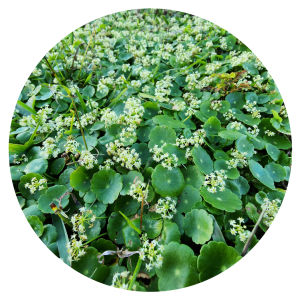Transforming Your Lawn into a Mixed-Mowables, Biodiverse, Low-Maintenance Oasis

Welcome to our Lawn Ornament blog series, where we explore one of the plethora of micro-plants that can help create a biodiverse, predominantly green, yet also delightfully colorful lawn that requires much less maintenance than a traditional grass lawn.
Many homeowners find it difficult and costly to maintain a “traditional” lawn, one largely dominated by a single turfgrass cultivar. Embracing a biodiverse landscape can help ease the frustration and save money, with the added bonus of providing ecological benefits. This “Lawn Ornament” series will provide a road map to that goal. Along the way, we’ll showcase volunteer “weeds” and commercially available ground covers that can add to the biodiversity of our lawns. And, we’ll offer you tips and techniques to adopt and embrace this biodiverse approach. Breaking free from “tradition,” we can transform yards and neighborhoods to vibrant, beautiful mixed-mowable ecosystems.

Benefits of a Mixed, Biodiverse Lawn
- Less Maintenance: Mixed biodiverse lawns require significantly less maintenance than traditional turfgrass lawns. You’ll spend less time mowing and dealing with common lawn problems.
- Reduced Chemical Use: With a diverse mix of plants instead of a monoculture, your lawn will be more resilient to pests and diseases, reducing the need for herbicides, pesticides, and fungicides. Additionally, you can skip synthetic fertilizers by relying on natural processes like nutrient cycling with a nitrogen fixing groundcover like perennial peanut or sunshine mimosa.
- Water Conservation: If you select the right plants for the right places in a biodiverse lawn you will require less water than a traditional St. Augustine lawn. This can lead to significant water savings.
- Ecological Benefits: Biodiverse lawns support a wide range of wildlife, from pollinators like bees and butterflies to birds and beneficial insects. This contributes to local biodiversity and helps create healthier urban ecosystems.
- Improved Soil Health: By diversifying your lawn, you enhance soil health, reduce erosion, and increase nutrient cycling, which benefits not only your lawn but the surrounding environment as well.
- Enhanced Aesthetics: Biodiverse lawns offer a unique and dynamic visual appeal, changing with the seasons as different plants bloom and thrive. It will be a living tapestry of color. An increasing number of homeowners find these lawns more attractive than the uniform bland look of traditional turfgrass lawns.
Road Map to a Mixed, Biodiverse Lawn
Step 1: Assess Your Lawn
Before you embark on this journey, take a close look at your existing lawn. Identify areas that are struggling due to poor soil quality, drainage issues, or excessive shade. Bring in soil samples to your local Extension office to have it analyzed (generally, for a small fee). In a lot of areas, turfgrass is not the right plant for the right place, the most important principle of Florida-Friendly Landscaping™. This assessment will help you plan the transformation effectively and determine where you can welcome the highlighted plant species into your new ornamental lawn.
Step 2: Choose the Right Plants
One of the key elements of creating a biodiverse mixed-mowable lawn is selecting the right base plants. Then adding additional ornaments, as needed, in places they will thrive. Or even allowing weeds that aren’t harmful to persist. Turfgrass can be the staple of this lawn, or you can opt for a nitrogen fixing groundcover like perennial peanut or sunshine mimosa, two plants that will be highlighted early on by this blog series. If you have the right plants, you will require less water, less herbicides, less pesticides, less fertilizer, and less maintenance than a traditional turfgrass monoculture. While also adding in beauty and ecological value to your landscape.
Base Lawn Ornaments (High Coverage, commercially available, spread quickly)
Sunshine Powderpuff Mimosa strigillosa (Native) – Blog Complete
Frogfruit Phyla nodiflora (Native)
Perennial Peanut Arachis glabrata (Nonnative)
Additional Ornaments (Need specialized conditions, are seasonal, less commercially available, some you shouldn’t spread but aren’t worth herbiciding)
Basketgrass Oplismenus setarius (Native) – Blog Complete
Oakleaf Fleabane Erigeron quercifolius (Native)
Herb-of-Grace Bacopa monnieri (Native) – Blog Complete
Florida Snow Richardia grandiflora (Nonnative) – Blog Complete
Spadeleaf Centella asiatica (Native)
Carolina Ponyfoot Dichondra carolinensis (Native)
Manyflower Pennywort Hydrocotyle umbellata (Native)
Bay Lobelia Lobelia feayana (Native)
Blue Eyed Grass Sisyrinchium angustifolium (Native)
Lyreleaf Sage Salvia lyrata (Native)
Blue Toadflax Linaria canadensis (Native)
Creeping River Sage Salvia misella (Native)
Pink Purslane Portulaca pilosa (Native)
Yellow Purslane Portulaca oleracea (Native)
Creeping Tick Trefoil Grona triflora (Nonnative)
Creeping Indigo Indigofera spicata (Nonnative)
Hop Clover Medicago lupulina – (Nonnative) – Blog Complete
White Clover Trifolium repens (Nonnative) – Blog Complete
Dandelion Taraxacum officinale (Nonnative)
Yellow Woodsorrel Oxalis corniculata (Native)
Pink Woodsorrel Oxalis debilis (Nonnative)
Butterfly Needles Bidens alba (Native)
Tickseed Coreopsis spp. (Native)
Milkwort Polygala spp. (Native)
Step 3: Establish your Biodiverse Lawn
Follow the planting instructions for your chosen plants carefully. Provide adequate water during the establishment phase to help the new plants thrive. Even if the selected species are drought tolerant and are the right plant for the right place, they will need regular watering and care for the establishment period. On the other hand, avoid fertilizing new plants. Most ground covers, shrubs, and trees do not respond well to fertilizer during the establishment period.
Step 4: Set a Mowing Schedule

- Mow High: Keep your mower blade at a higher setting to allow your plants to grow taller. This promotes a healthier ecosystem, as plants are able to flower and seed properly. Many plants, including turf, are able to create deeper root systems if you mow high.
- Mow Strategically: Mow paths or designated areas for walking and recreational activities while leaving other patches of the lawn to grow naturally. This approach strikes a balance between aesthetics and biodiversity.
- Mow Less Often: Aim to mow your biodiverse lawn less often. Pollinators and other wildlife benefit by letting the grasses and wildflowers bloom and set seed.
Conclusion
Transforming your traditional turfgrass lawn into a mixed, biodiverse oasis is not only environmentally responsible but also practical and rewarding. By following these steps, you can enjoy a low-maintenance lawn that teems with life, conserves resources, and enhances the beauty of your outdoor space. Largely the only thing holding us back from this landscape revolution is our cultural traditions. I hope you embrace the biodiversity and reap the benefits of these lawn ornaments. Enjoy the blog series, and if you have discovered a plant that thrives in your lawn, please reach out so we can feature it!
During the preparation of this work, the author used ChatGPT to help build the blog post. After using this tool/service, the author reviewed and edited the content, and takes full responsibility for the content of the publication.
 19
19


























